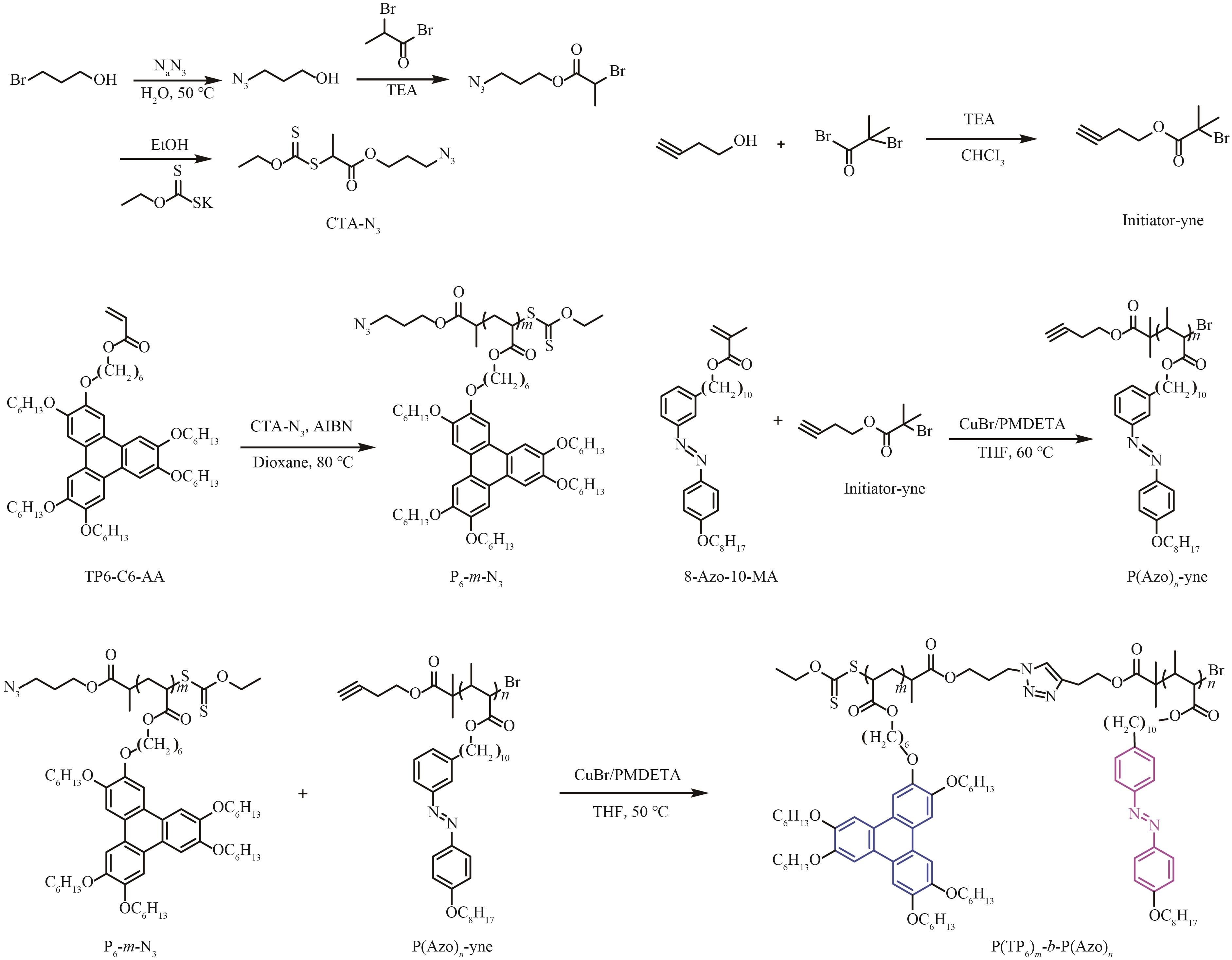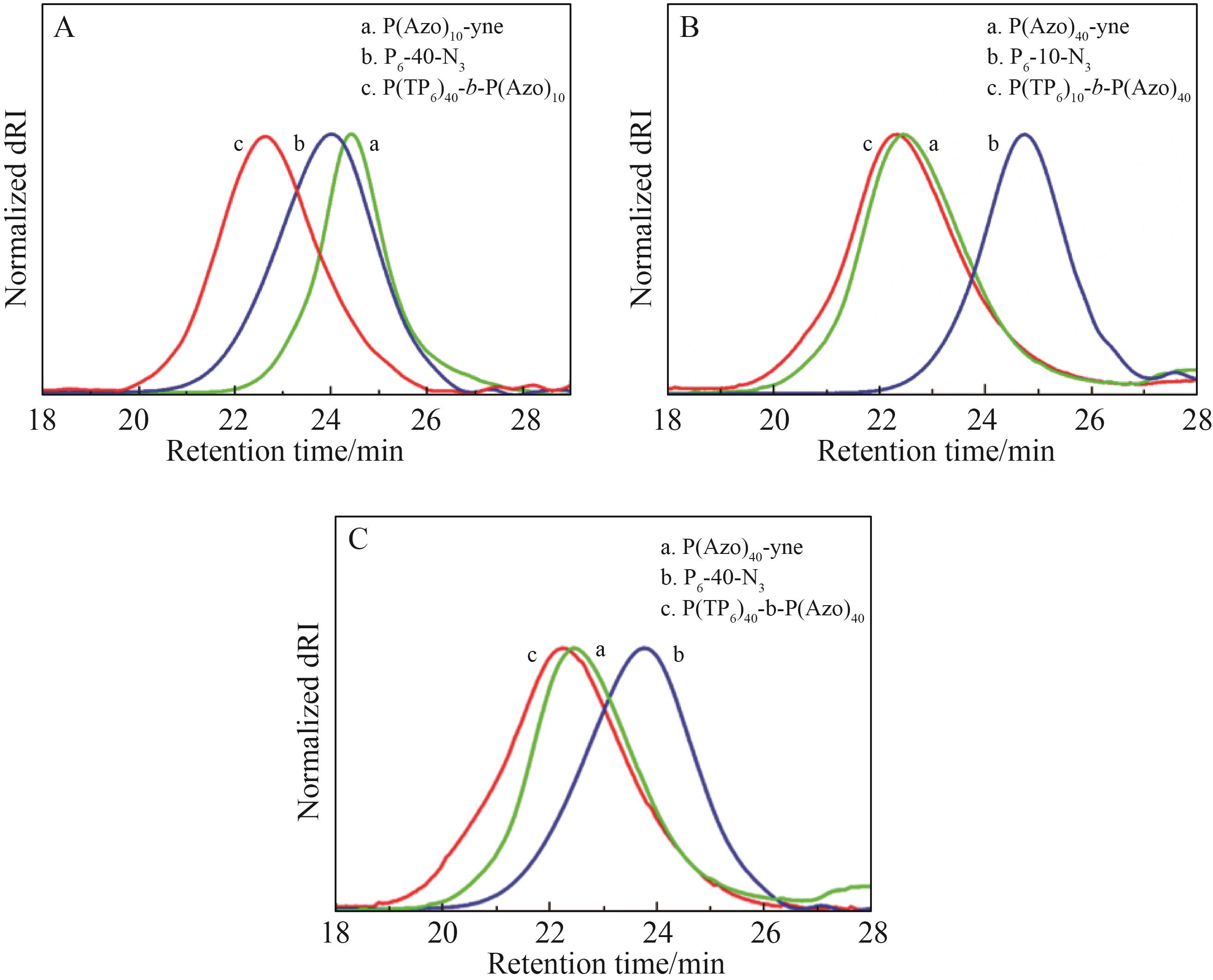
Chinese Journal of Applied Chemistry ›› 2021, Vol. 38 ›› Issue (10): 1340-1352.DOI: 10.19894/j.issn.1000-0518.210343
• Full Papers • Previous Articles Next Articles
Controlled Synthesis and Photophysical Properties of Liquid Crystalline Diblock Copolymers with Side⁃Chain Discotic Triphylene and Calamitic Azobenzene Mesogens
Zhao-Yong ZHANG1‡, Qian LI1‡, Da-Lin WANG1, Jiang-Lin FANG2, Dong-Zhong CHEN1( )
)
- 1Key Laboratory of High Performance Polymer Materials and Technology of Ministry of Education,Department of Polymer Science and Engineering,School of Chemistry and Chemical Engineering,Nanjing University,Nanjing 210023,China
2Center of Modern Analysis,Nanjing University,Nanjing 210093,China
-
Received:2021-07-16Accepted:2021-08-31Published:2021-10-01Online:2021-10-15 -
Contact:Dong-Zhong CHEN -
About author:cdz@nju.edu.cn
-
Supported by:National Natural Science Foundation of China(21875098)
CLC Number:
Cite this article
Zhao-Yong ZHANG, Qian LI, Da-Lin WANG, Jiang-Lin FANG, Dong-Zhong CHEN. Controlled Synthesis and Photophysical Properties of Liquid Crystalline Diblock Copolymers with Side⁃Chain Discotic Triphylene and Calamitic Azobenzene Mesogens[J]. Chinese Journal of Applied Chemistry, 2021, 38(10): 1340-1352.
share this article
Add to citation manager EndNote|Ris|BibTeX
URL: http://yyhx.ciac.jl.cn/EN/10.19894/j.issn.1000-0518.210343
聚合物代号 Polymer code | 设计聚合度 Designed DP | 设计相对分子质量 Designed MW | 凝胶渗透色谱GPC | ||
|---|---|---|---|---|---|
质均相对分子质量 Mw,GPC | 数均相对分子质量 Mn,GPC | 多分散指数 PDI | |||
| P6?10?N3 | 10 | 9 300 | 9 500 | 7 200 | 1.31 |
| P6?40?N3 | 40 | 36 300 | 17 000 | 12 500 | 1.36 |
| P(Azo)10?yne | 10 | 5 400 | 8 300 | 7 000 | 1.19 |
| P(Azo)40?yne | 40 | 21 300 | 35 000 | 24 400 | 1.43 |
| P(TP6)40?b?P(Azo)10 | / | 41 700 | 36 300 | 24 800 | 1.46 |
| P(TP6)10?b?P(Azo)40 | / | 30 600 | 38 900 | 26 000 | 1.49 |
| P(TP6)40?b?P(Azo)40 | / | 57 600 | 41 300 | 27 500 | 1.50 |
Table 1 Molecular characterization results of disk?rod hybrid diblock copolymers with different DP and their corresponding homopolymers via GPC
聚合物代号 Polymer code | 设计聚合度 Designed DP | 设计相对分子质量 Designed MW | 凝胶渗透色谱GPC | ||
|---|---|---|---|---|---|
质均相对分子质量 Mw,GPC | 数均相对分子质量 Mn,GPC | 多分散指数 PDI | |||
| P6?10?N3 | 10 | 9 300 | 9 500 | 7 200 | 1.31 |
| P6?40?N3 | 40 | 36 300 | 17 000 | 12 500 | 1.36 |
| P(Azo)10?yne | 10 | 5 400 | 8 300 | 7 000 | 1.19 |
| P(Azo)40?yne | 40 | 21 300 | 35 000 | 24 400 | 1.43 |
| P(TP6)40?b?P(Azo)10 | / | 41 700 | 36 300 | 24 800 | 1.46 |
| P(TP6)10?b?P(Azo)40 | / | 30 600 | 38 900 | 26 000 | 1.49 |
| P(TP6)40?b?P(Azo)40 | / | 57 600 | 41 300 | 27 500 | 1.50 |
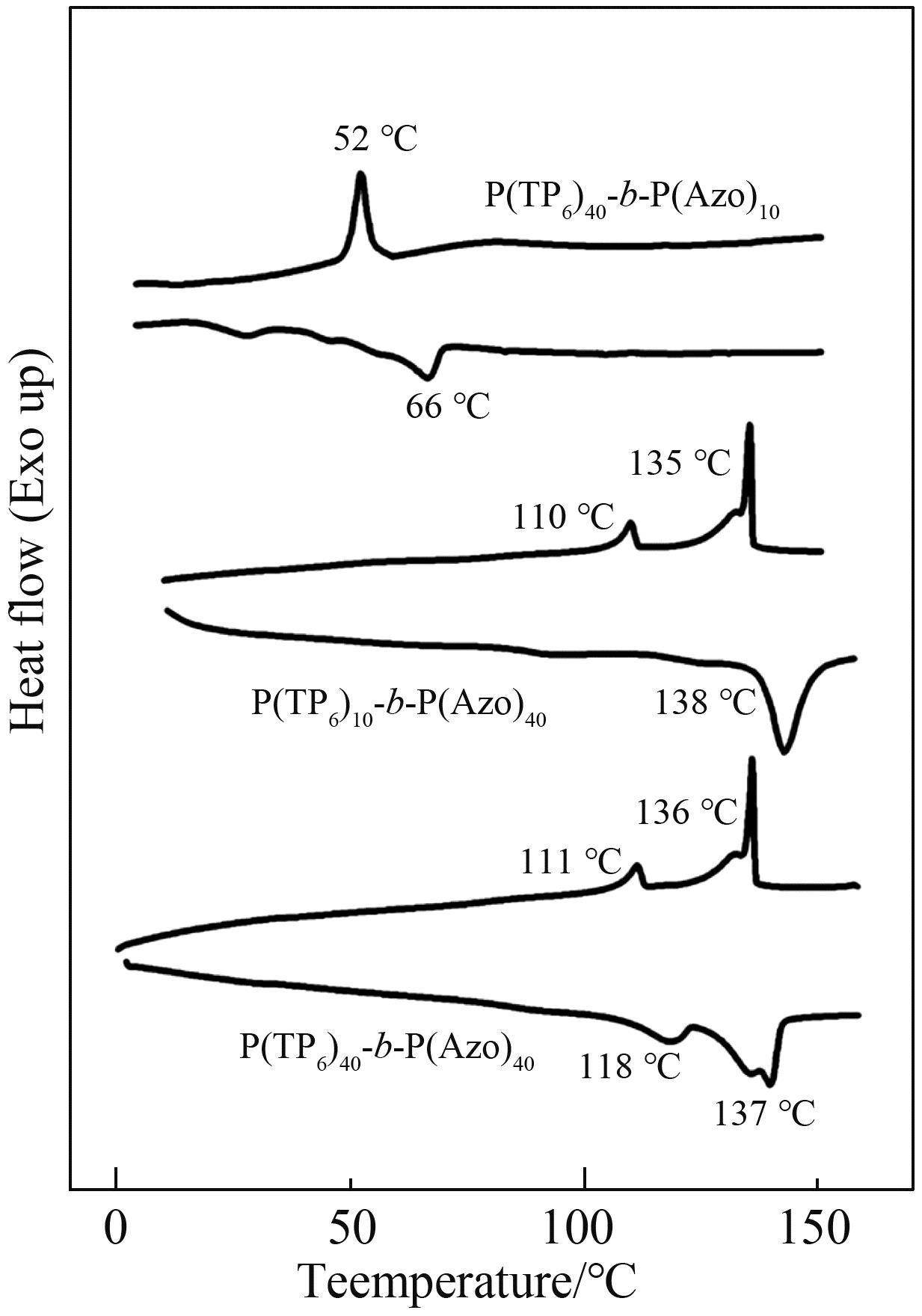
Fig.2 DSC curves of disk-rod hybrid diblock copolymers with variant block lengths during the first cooling and second heating scans at a rate of 10 ℃/min under a nitrogen atmosphere
聚合物代号 Polymer code | 相转变温度/℃(焓变/(J·g-1)) Phase transitions/℃(Enthalpy changes/(J·g-1)) | |
|---|---|---|
第1次降温 First cooling | 第2次升温 Second heating | |
| P(TP6)40?b?P(Azo)10 | I 52(7.5) Col | Col 26, 47, 58, 66(-7.1) I |
| P(TP6)10?b?P(Azo)40 | I 135(3.5) N 130(4.0) SmC 110(1.8) | SmC 138(-6.6) I |
| P(TP6)40?b?P(Azo)40 | I 136(3.5) N 131(4.0) SmC 111(1.8) | SmC 118(-2.0) N 132(-3.2) 137(-3.5) I |
Table 2 Thermal data and phase assignments of the series diblock copolymers of P(TP6)m?b?P(Azo)n
聚合物代号 Polymer code | 相转变温度/℃(焓变/(J·g-1)) Phase transitions/℃(Enthalpy changes/(J·g-1)) | |
|---|---|---|
第1次降温 First cooling | 第2次升温 Second heating | |
| P(TP6)40?b?P(Azo)10 | I 52(7.5) Col | Col 26, 47, 58, 66(-7.1) I |
| P(TP6)10?b?P(Azo)40 | I 135(3.5) N 130(4.0) SmC 110(1.8) | SmC 138(-6.6) I |
| P(TP6)40?b?P(Azo)40 | I 136(3.5) N 131(4.0) SmC 111(1.8) | SmC 118(-2.0) N 132(-3.2) 137(-3.5) I |

Fig.3 POM images of the diblock copolymer P(TP6)40-b-P(Azo)10 under crossed polarizers (A) at room temperature, (B) heating up to isotropic phase and (C) slowly cooling down to room temperature

Fig.4 POM images of the diblock copolymers P(TP6)10-b-P(Azo)40 (A—F) and P(TP6)40-b-P(Azo)40 (G—L) under crossed polarizers upon heating from room temperature to the isotropic phase
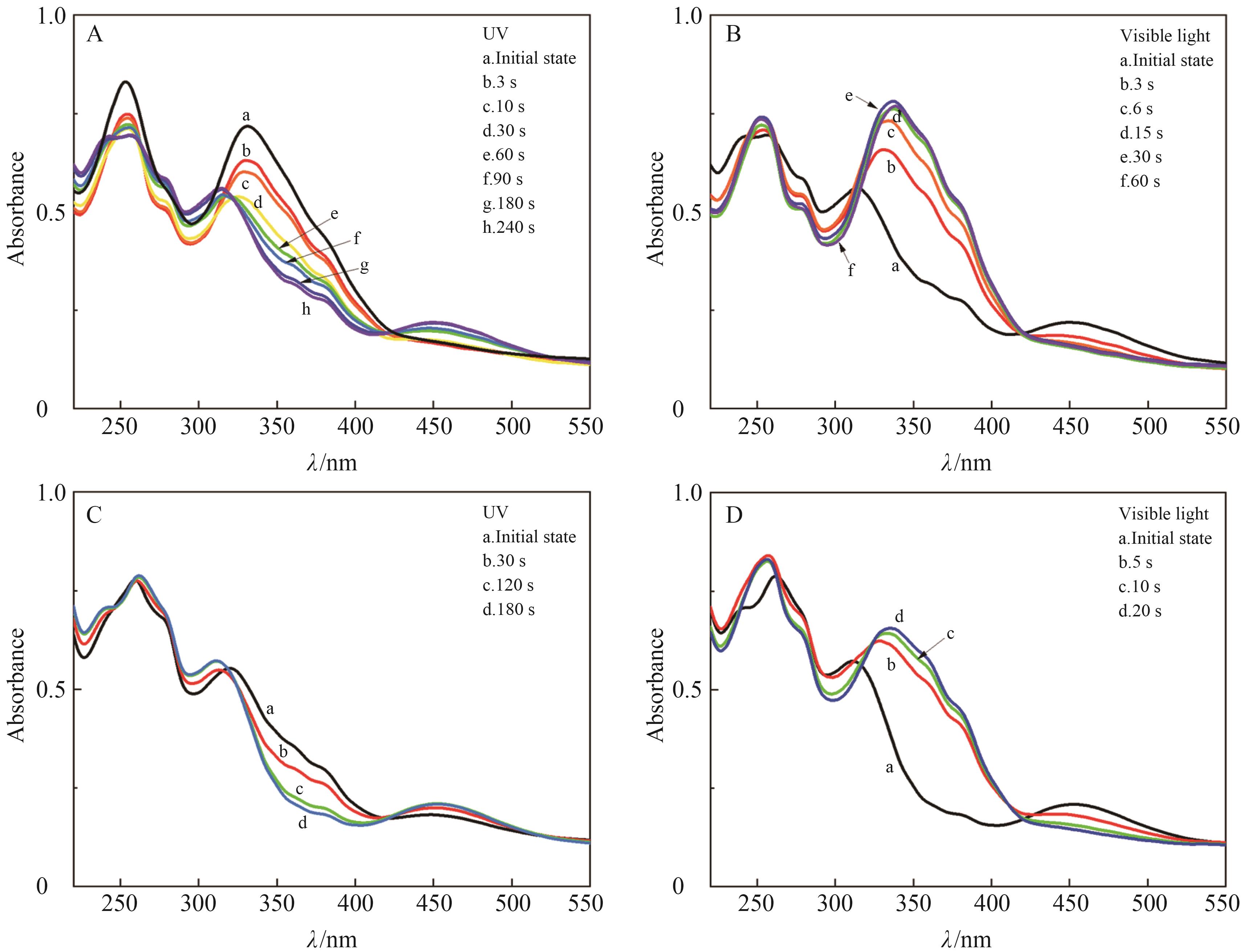
Fig.5 UV-Vis absorption spectra of the diblock copolymer films of (A) P(TP6)10-b-P(Azo)40 under irradiation of 365 nm UV light, and (B) recovery under illumination of the visible light; (C) P(TP6)40-b-P(Azo)40 under irradiation of 365 nm UV light, and (D) recovery under illumination of the visible light
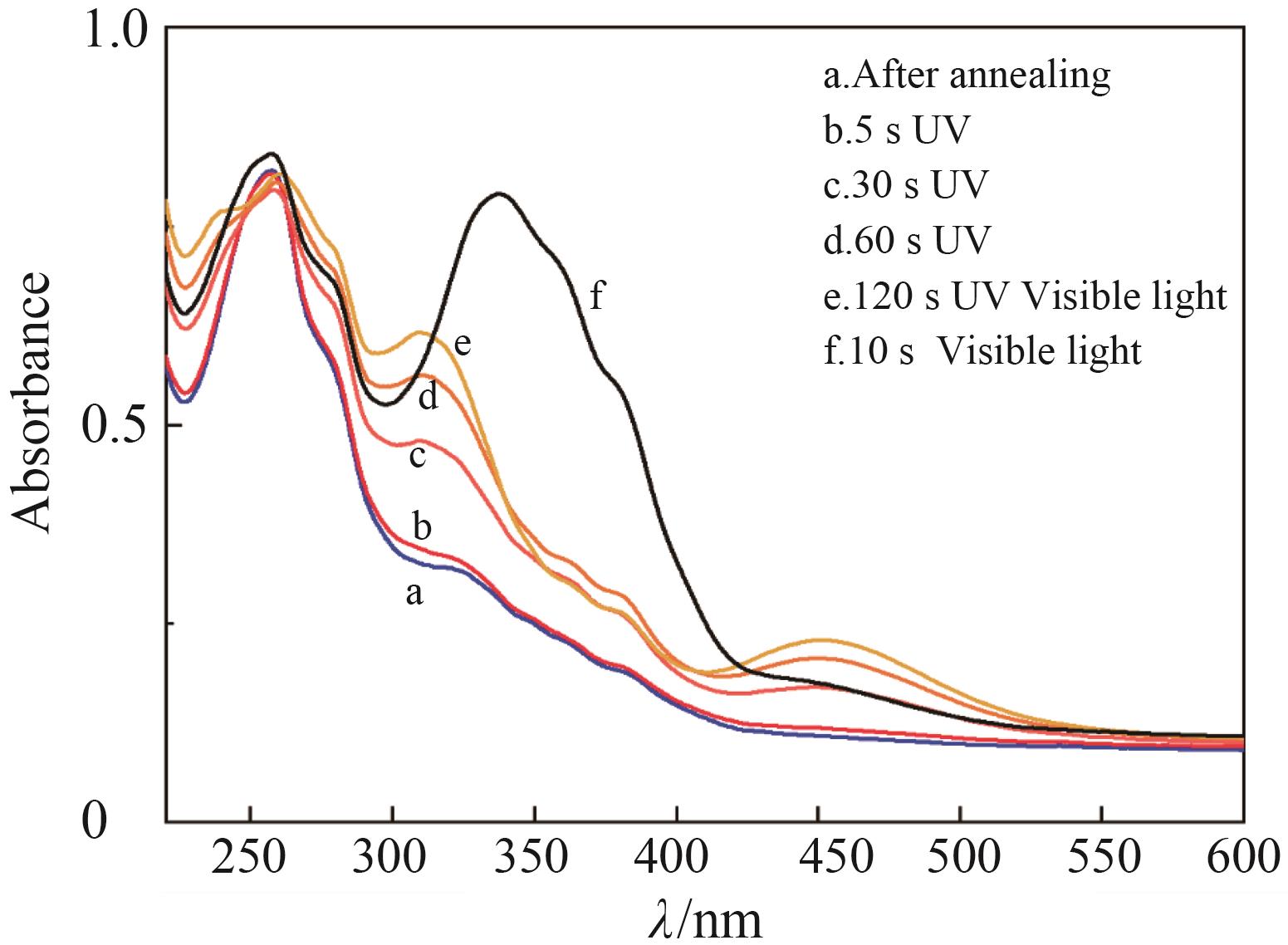
Fig.6 UV-Vis absorption spectra of the diblock copolymer film of P(TP6)40-b-P(Azo)40 after annealing (a), irradiated with 365 nm UV light for different time to cis photostationary state (b—e), and then illuminated with visible light transforming back to trans state (f)
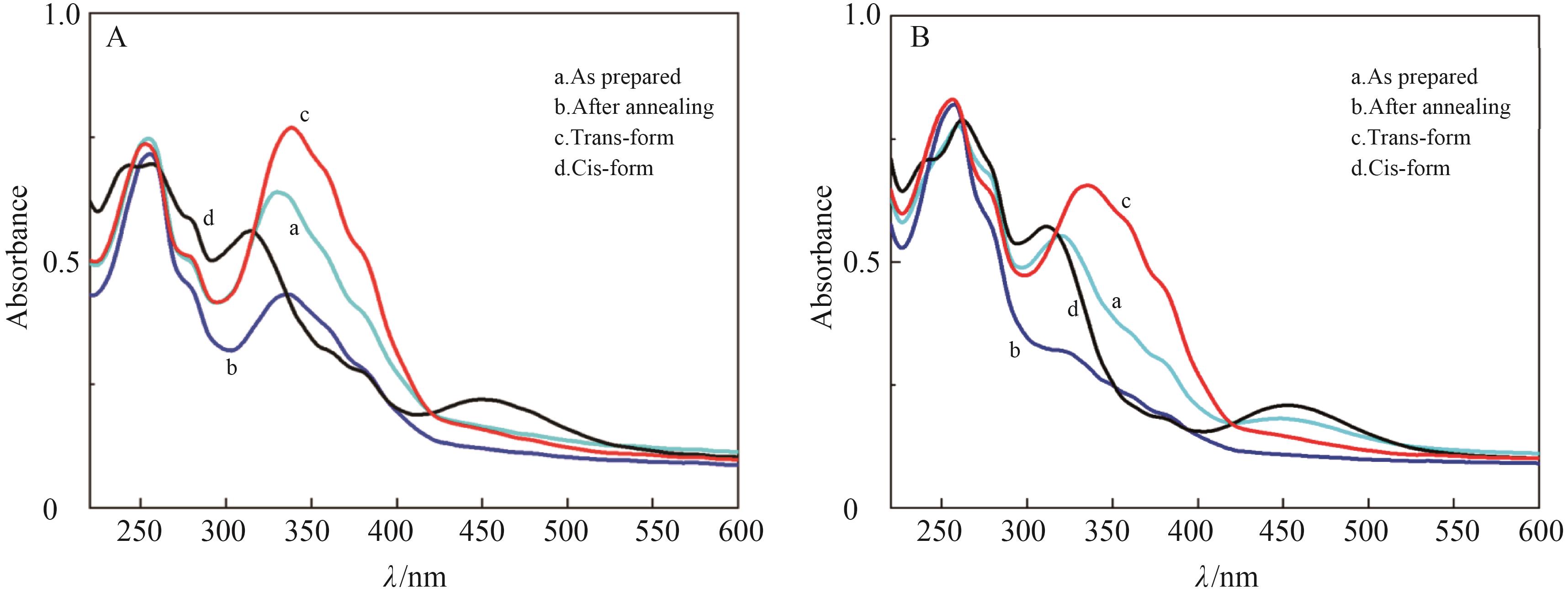
Fig.7 UV-Vis absorption spectra comparison of the diblock copolymer films of (A) P(TP6)10-b-P(Azo)40 and (B) P(TP6)40-b-P(Azo)40 at different states, as-prepared spin coating film (a), after annealing (b), trans steady state (c) and cis photostationary state (d)
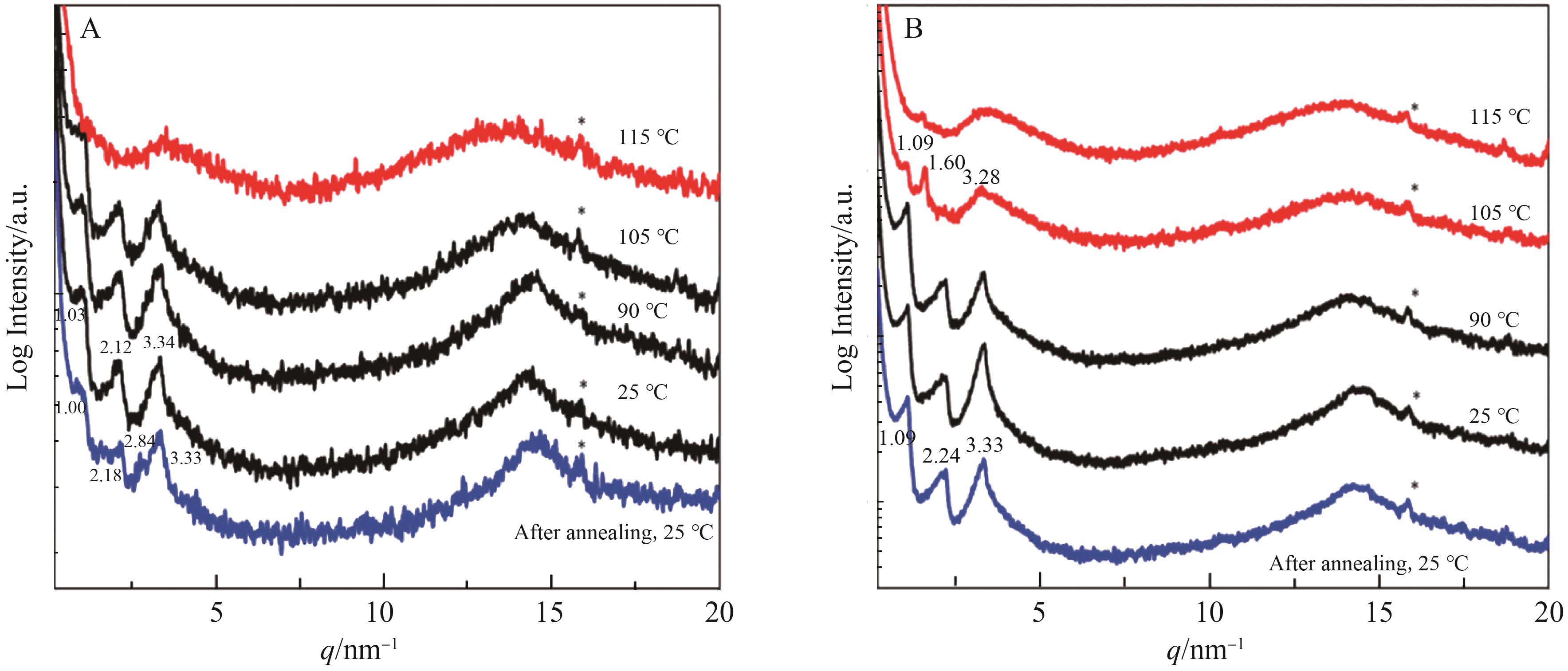
Fig.8 Variable temperature SAXS/WAXS curves of (A) P(TP6)10-b-P(Azo)40 and (B) P(TP6)40-b-P(Azo)40, the peaks marked with a star * standing for the background signal from the aluminum foil base
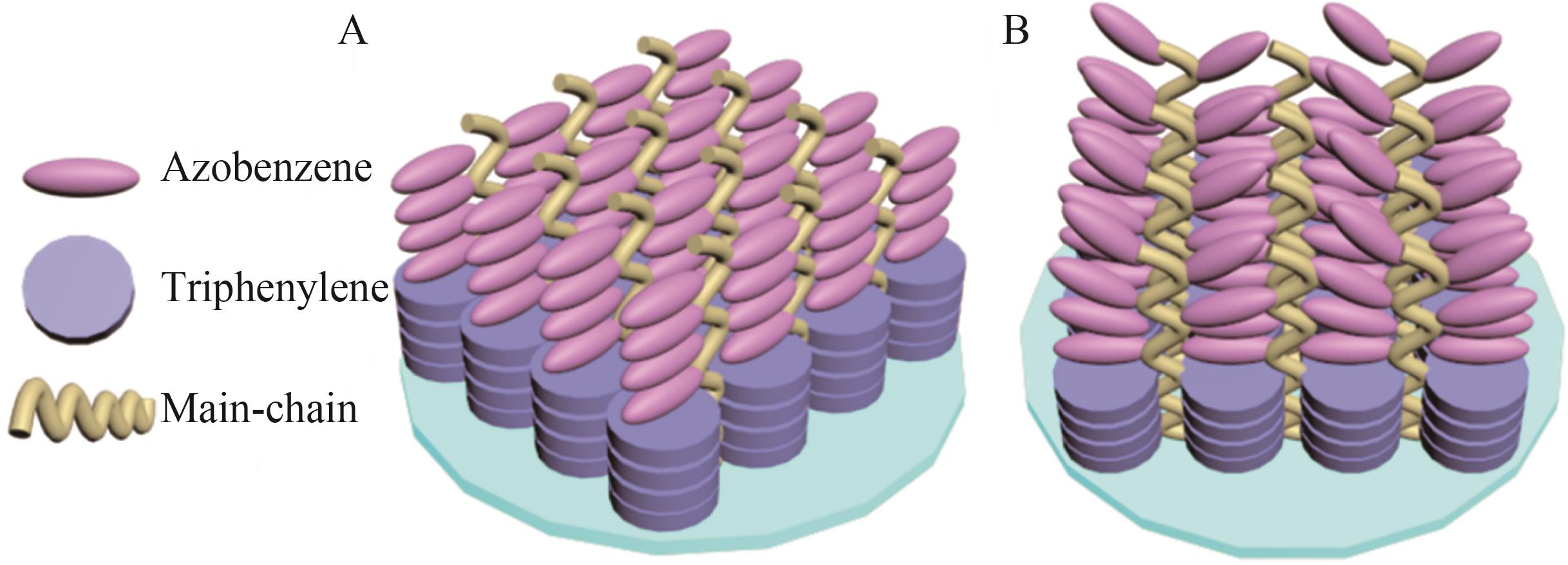
Fig.9 (A) Schematic illustration of the discotic triphenylene induced planar orientation of calamitic azobenzene mesogens in disc-rod diblock copolymer films of P(TP6)40-b-P(Azo)40 and P(TP6)10-b-P(Azo)40 with a longer azobenzene block, and (B) the orientational change after irradiation with 365 nm ultraviolet then visible light
| 1 | FLETCHER I D, LUCKHURST G R. The synthesis and characterization of novel nonsymmetrical dimers with rod-like and disk-like mesogenic units[J]. Liq Cryst, 1995, 18(2): 175-183. |
| 2 | TSCHIERSKE C, PHOTINOS D J. Biaxial nematic phases[J]. J Mater Chem, 2010, 20(21): 4263-4294. |
| 3 | MADSEN L A, DINGEMANS T J, NAKATA M, et al. Thermotropic biaxial nematic liquid crystals[J]. Phys Rev Lett, 2004, 92(14): 145505. |
| 4 | ACHARYA B R, PRIMAK A, KUMAR S. Biaxial nematic phase in bent-core thermotropic mesogens[J]. Phys Rev Lett, 2004, 92(14): 145506. |
| 5 | PRASAD V, KANG S W, SURESH K A, et al. Thermotropic uniaxial and biaxial nematic and smectic phases in bent-core mesogens[J]. J Am Chem Soc, 2005, 127(49): 17224-17227. |
| 6 | KEITH C, LEHMANN A, BAUMEISTER U, et al. Nematic phases of bent-core mesogens[J]. Soft Matter, 2010, 6(8): 1704-1721. |
| 7 | MAEDA H, TERASHIMA Y, HAKETA Y, et al. Discotic columnar mesophases derived from ‘rod-like’ pi-conjugated anion-responsive acyclic oligopyrroles[J]. Chem Commun, 2010, 46(25): 4559-4561. |
| 8 | MATRASZEK J, GRZESKIEWICZ K, GORECKA E, et al. Fluorescent bent-core mesogens with thiophene-based central unit[J]. Liq Cryst, 2020, 47(12): 1803-1810. |
| 9 | CIGL M, HAMPLOVA V, POCIECHA D, et al. Photosensitive bent-core compounds with azo-group attached to the central ring[J]. Crystals, 2020, 10(11): 14. |
| 10 | SKOPALOVA H, KOZMIK V, SMAHEL M, et al. Mesomorphic properties of non-symmetric bent-core liquid crystals with a lateral substituent in the apex position[J]. Liq Cryst, 2021, 48(7): 1010-1024. |
| 11 | APREUTESEI D, MEHL G H. Completely miscible disc and rod shaped molecules in the nematic phase[J]. Chem Commun, 2006(6): 609-611. |
| 12 | DATE R W, BRUCE D W. Shape amphiphiles: mixing rods and disks in liquid crystals[J]. J Am Chem Soc, 2003, 125(30): 9012-9013. |
| 13 | HUNT J J, DATE R W, TIMIMI T A, et al. Toward the biaxial nematic phase of low molar mass thermotropic mesogens: substantial molecular biaxiality in covalently linked rod-disk dimers[J]. J Am Chem Soc, 2001, 123(41): 10115-10116. |
| 14 | IMRIE C T, LU Z B, PICKENS J, et al. Oligomeric rod-disc nematic liquid crystals[J]. Chem Commun, 2007(12): 1245-1247. |
| 15 | JEONG K U, JING A J, MANSDORF B, et al. Biaxial molecular arrangement of rod-disc molecule under an electric field[J]. Chem Mater, 2007, 19(12): 2921-2923. |
| 16 | JEONG K U, JING A J, MANSDORF B, et al. Self-assembly of chemically linked rod-disc mesogenic liquid crystals[J]. J Phys Chem B, 2007, 111(4): 767-777. |
| 17 | KOUWER P H J, MEHL G H. Multiple levels of order in linked disc-rod liquid crystals[J]. Angew Chem Int Ed, 2003, 42(48): 6015-6018. |
| 18 | KOUWER P H J, MEHL G H. Full miscibility of disk- and rod-shaped mesogens in the nematic phase[J]. J Am Chem Soc, 2003, 125(37): 11172-11173. |
| 19 | KOUWER P H J, MEHL G H. Hierarchical organisation in shape-amphiphilic liquid crystals[J]. J Mater Chem, 2009, 19(11): 1564-1575. |
| 20 | KOUWER P H J, POURZAND J, MEHL G H. Disc-shaped triphenylenes in a smectic organisation[J]. Chem Commun, 2004(1): 66-67. |
| 21 | KOUWER P H J, WELCH C J, MCROBBIE G, et al. Mixtures of disc-shaped and rod-shaped mesogens with chiral components[J]. J Mater Chem, 2004, 14(12): 1798-1803. |
| 22 | MAHLSTEDT S, JANIETZ D, SCHMIDT C, et al. Novel donor-acceptor triple mesogens incorporating disc-like and rod-like molecular sub-units[J]. Liq Cryst, 1999, 26(9): 1359-1369. |
| 23 | PAL S K, KUMAR S, SETH J. Synthesis and characterisation of novel rod-disc oligomers[J]. Liq Cryst, 2008, 35(5): 521-525. |
| 24 | RAHMAN M L, TSCHIERSKE C, YUSOFF M, et al. Synthesis and liquid crystalline properties of a disc-shaped molecule with azobenzene at the periphery[J]. Tetrahedron Lett, 2005, 46(13): 2303-2306. |
| 25 | SHIMIZU Y, KUROBE A, MONOBE H, et al. Calamitic and discotic mesophases formed by kinetically controlled rod-disc alternation of molecular shape in a triphenylene-azobenzene mesogenic system[J]. Chem Commun, 2003(14): 1676-1677. |
| 26 | TANAKA D, ISHIGURO H, SHIMIZU Y, et al. Thermal and photoinduced liquid crystalline phase transitions with a rod-disc alternative change in the molecular shape[J]. J Mater Chem, 2012, 22(48): 25065-25071. |
| 27 | DEVI S, BALA I, GUPTA S P, et al. Reversibly photoswitchable alkoxy azobenzenes connected benzenetricarboxamide discotic liquid crystals with perpetual long range columnar assembly[J]. Org Biomol Chem, 2019, 17(7): 1947-1954. |
| 28 | SPERNER M, TOBER N, DETERT H. Tristriazolotriazines with azobenzene arms-acidochromic dyes and discotic liquid crystals[J]. Eur J Org Chem, 2019(29): 4688-4693. |
| 29 | LIU Y R, LI W, ZHOU X, et al. Highly ordered smectic structures of disc-rod luminescent liquid crystals: the role of the tolane group[J]. J Mater Chem C, 2021, 9(10): 3555-3561. |
| 30 | EBERT M, WENDORFF J H. Polyesters containing both rod-like and disc-like mesogens[J]. Makromol Chem, 1992, 193(2): 507-513. |
| 31 | PAN S, MU B, ZHOU Y, et al. Competition and compromise between discotic and calamitic mesogens in triphenylene and azobenzene based shape-amphiphilic liquid crystals[J]. RSC Adv, 2016, 6(55): 49556-49566. |
| 32 | WU B, MU B, CHEN D Z, et al. Triphenylene-based side chain liquid crystalline block copolymers containing a PEG block: controlled synthesis, microphase structures evolution and their interplay with discotic mesogenic orders[J]. Macromolecules, 2013, 46(8): 2916-2929. |
| 33 | MU B, WU B, CHEN D Z, et al. Hierarchical self-organization and uniaxial alignment of well synthesized side-chain discotic liquid crystalline polymers[J]. Macromolecules, 2015, 48(8): 2388-2398. |
| 34 | LI X, MU B, CHEN D Z, et al. Significantly enhanced thermotropic liquid crystalline columnar mesophases in stereoregular polymethylenes with discotic triphenylene side groups[J]. Macromolecules, 2019, 52(18): 6913-6926. |
| 35 | MU B, PAN S, CHEN D Z, et al. Well-organized columnar superlattices via positive coupling between polymer backbone and discotic side groups[J]. Macromolecules, 2015, 48(19): 6768-6780. |
| 36 | SHI Z H, LU H J, CHEN D Z, et al. Rational design, syntheses, characterization and solution behavior of amphiphilic azobenzene-containing linear-dendritic block copolymers[J]. Polymer 2012, 53(2): 359-369. |
| 37 | DUAN J F, MA J, CHEN D Z, et al. Formation of persistent ordered lamellar mesophases in azobenzene-containing silver thiolates and their implications for controlled synthesis of silver nanomaterials[J]. J Mater Chem C, 2014, 2(13): 2375-2386. |
| 38 | PAN S, NI M F, CHEN D Z, et al. Well-defined pillararene-based azobenzene liquid crystalline photoresponsive materials and their thin films with photomodulated surfaces[J]. Adv Funct Mater, 2015, 25(23): 3571-3580. |
| 39 | CHEN J, XU T C, CHEN D Z, et al. Photoresponsive thin films of well-synthesized azobenzene side-chain liquid crystalline polynorbornenes as command surface for patterned graphic writing[J]. Polymer, 2021, 218: 123492. |
| 40 | PAN S, MU B, CHEN D Z, et al. Chapter 5, Side-chain liquid crystalline polymers: controlled synthesis and hierarchical structure characterization[M]//THAKUR V K, KESSLER M R. Liquid Crystalline Polymers: Volume 1-Structure and Chemistry. Dordrecht: Springer, 2016: 131-172. |
| 41 | VISWANATHAN N K, KIM D Y, BIAN S, et al. Surface relief structures on azo polymer films[J]. J Mater Chem, 1999, 9(9): 1941-1955. |
| 42 | LI Z B, ZHANG Y, ZHU L R, et al. Efficient synthesis of photoresponsive azobenzene-containing side-chain liquid crystalline polymers with high molecular weights by click chemistry[J]. Polym Chem, 2010, 1(9): 1501-1511. |
| 43 | NATANSOHN A, ROCHON P. Photoinduced motions in azo-containing polymers[J]. Chem Rev, 2002, 102(11): 4139-4175. |
| 44 | ICHIMURA K. Photoalignment of liquid-crystal systems[J]. Chem Rev, 2000, 100(5): 1847-1873. |
| 45 | 慕斌, 吴斌, 谌东中. 苯并菲盘状侧链液晶聚合物的大分子工程[J]. 高分子学报, 2017(10): 1574-1590. |
| MU B, WU B, CHEN D Z. Macromolecular engineering on triphenylene based discotic side-chain liquid crystalline polymers[J]. Acta Polym Sin, 2017(10): 1574-1590. | |
| 46 | GONG M Q, WANG R, CHEN D Z, et al. Self-assembly behavior of triphenylene-based side-chain discotic liquid crystalline polymers[J]. Macromolecules, 2017, 50(14): 5556-5564. |
| 47 | WU M, WANG R, CHEN D Z, et al. Effect of grafting density on the self-assembly of side-chain discotic liquid crystalline polymers with triphenylene discogens[J]. Soft Matter, 2020, 16(2): 375-382. |
| [1] | Zhao-Yong ZHANG, Qian LI, Da-Lin WANG, Jiang-Lin FANG, Dong-Zhong CHEN. Controlled Synthesis and Photophysical Properties of Liquid Crystalline Diblock Copolymers with Side⁃Chain Discotic Triphylene and Calamitic Azobenzene Mesogens [J]. Chinese Journal of Applied Chemistry, 2021, 38(10): 0-0. |
| Viewed | ||||||
|
Full text |
|
|||||
|
Abstract |
|
|||||
